Effective Recovery of Gold from Chloride Multi-Metal Solutions Through Anion Exchange
Abstract
:1. Introduction
2. Results and Discussion
2.1. Batch Adsorption Kinetics and Isotherms Experiments
2.2. Column Experiments
2.2.1. Optimization of Adsorption and Elution Conditions
2.2.2. Concentration and Selectivity Ability of Resins for Gold
3. Materials and Methods
3.1. Reagents and Analytical Techniques
3.2. Batch Experiments
3.2.1. Adsorption Kinetics
3.2.2. Adsorption Isotherms
3.3. Column Experimental Conditions
3.4. Computer Chemical Simulations
3.5. Porosity Determination
4. Conclusions
Author Contributions
Funding
Data Availability Statement
Conflicts of Interest
References
- Ok, Y.S.; Jeon, C. Selective adsorption of the gold–cyanide complex from waste rinse water using Dowex 21K XLT resin. J. Ind. Eng. Chem. 2014, 20, 1308–1312. [Google Scholar] [CrossRef]
- Dong, Z.; Liu, J.; Yuan, W.; Yi, Y.; Zhao, L. Recovery of Au(III) by radiation synthesized aminomethyl pyridine functionalized adsorbents based on cellulose. Chem. Eng. J. 2016, 283, 504–513. [Google Scholar] [CrossRef]
- Ahamed, M.E.H.; Mbianda, X.Y.; Mulaba-Bafubiandi, A.F.; Marjanovic, L. Selective extraction of gold(III) from metal chloride mixtures using ethylenediamine N-(2-(1-imidazolyl)ethyl) chitosan ion-imprinted polymer. Hydrometallurgy 2013, 140, 1–13. [Google Scholar] [CrossRef]
- Erim, Ü.C.; Gülfen, M.; Aydın, A.O. Separation of gold(III) ions by 1,8-diaminonaphthalene-formaldehyde chelating polymer. Hydrometallurgy 2013, 134–135, 87–95. [Google Scholar] [CrossRef]
- Pang, S.-K.; Yung, K.-C. Prerequisites for achieving gold adsorption by multiwalled carbon nanotubes in gold recovery. Chem. Eng. Sci. 2014, 107, 58–65. [Google Scholar] [CrossRef]
- Gurung, M.; Adhikari, B.B.; Gao, X.; Alam, S.; Inoue, K. Sustainability in the Metallurgical Industry: Chemically Modified Cellulose for Selective Biosorption of Gold from Mixtures of Base Metals in Chloride Media. Ind. Eng. Chem. Res. 2014, 53, 8565–8576. [Google Scholar] [CrossRef]
- Xiong, C.; Zhou, S.; Liu, X.; Jia, Q.; Ma, C.; Zheng, X. 2-Aminothiazole Functionalized Polystyrene for Selective Removal of Au(III) in Aqueous Solutions. Ind. Eng. Chem. Res. 2014, 53, 2441–2448. [Google Scholar] [CrossRef]
- Pilśniak-Rabiega, M.; Trochimczuk, A.W. Selective recovery of gold on functionalized resins. Hydrometallurgy 2014, 146, 111–118. [Google Scholar] [CrossRef]
- Wołowicz, A.; Hubicki, Z. Adsorption characteristics of noble metals on the strongly basic anion exchanger Purolite A-400TL. J. Mater. Sci. 2014, 49, 6191–6202. [Google Scholar] [CrossRef]
- Sousa, R.; Regufe, M.J.; Fiúza, A.; Leite, M.M.; Futuro, A. A systematic review of sustainable gold extraction from raw ores using alternative leaching reagents. Extr. Ind. Soc. 2022, 9, 101018. [Google Scholar] [CrossRef]
- Sethurajan, M.; van Hullebusch, E.D.; Fontana, D.; Akcil, A.; Deveci, H.; Batinic, B.; Chmielarz, A. Recent advances on hydrometallurgical recovery of critical and precious elements from end of life electronic wastes—A review. Crit. Rev. Environ. Sci. Technol. 2019, 49, 212–275. [Google Scholar] [CrossRef]
- Green, B.R.; Kotze, M.H.; Wyethe, J.P. Developments in ion exchange: The mintek perspective. JOM 2002, 54, 37–43. [Google Scholar] [CrossRef]
- Yahorava, V.; Kotze, M.H. Novel application of a gold cyanide selective resin in the PGMs industry. In Hydrometallurgy; Canadian Institute of Mining, Metallurgy and Petroleum: Montreal, QC, Canada, 2014; Volume 2, pp. 269–279. [Google Scholar]
- Dicinoski, G.W.; Gahan, L.R.; Lawson, P.J.; Rideout, J.A. Application of the shrinking core model to the kinetics of extraction of gold(I), silver(I) and nickel(II) cyanide complexes by novel anion exchange resins. Hydrometallurgy 2000, 56, 323–336. [Google Scholar] [CrossRef]
- Azizitorghabeh, A.; Mahandra, H.; Ramsay, J.; Ghahreman, A. Selective gold recovery from pregnant thiocyanate leach solution using ion exchange resins. Hydrometallurgy 2023, 218, 106055. [Google Scholar] [CrossRef]
- Zhang, H.; Dreisinger, D.B. The recovery of gold from ammoniacal thiosulfate solutions containing copper using ion exchange resin columns. Hydrometallurgy 2014, 72, 225–234. [Google Scholar] [CrossRef]
- Negrea, A.; Mihailescu, M.; Mosoarca, G.; Ciopec, M.; Duteanu, N.; Negrea, P.; Minzatu, V.E. Estimation on fixed-bed column parameters of breakthrough behaviors for gold recovery by adsorption onto modified/functionalized amberlite xad7. Int. J. Environ. Res. Public Health 2020, 17, 6868. [Google Scholar] [CrossRef]
- Mohebbi, A.; Abolghasemi Mahani, A.; Izadi, A. Ion exchange resin technology in recovery of precious and noble metals. In Applications of Ion Exchange Materials in Chemical and Food Industries; Inamuddin, R.T.A., Asiri, A.M., Eds.; Springer International Publishing: Cham, Switzerland, 2019; pp. 193–258. [Google Scholar]
- Donia, A.M.; Yousif, A.M.; Atia, A.A.; Elsamalehy, M.F. Efficient adsorption of Ag(I) and Au(III) on modified magnetic chitosan with amine functionalities. Desalination Water Treat 2014, 52, 2537–2547. [Google Scholar] [CrossRef]
- Yang, J.; Kubota, F.; Baba, Y.; Kamiya, N.; Goto, M. Application of cellulose acetate to the selective adsorption and recovery of Au(III). Carbohydr. Polym. 2014, 111, 768–774. [Google Scholar] [CrossRef]
- Fan, R.; Xie, F.; Guan, X.; Zhang, Q.; Luo, Z. Selective adsorption and recovery of Au(III) from three kinds of acidic systems by persimmon residual based bio-sorbent: A method for gold recycling from e-wastes. Bioresour. Technol. 2014, 163, 167–171. [Google Scholar] [CrossRef]
- Neto, I.F.; Sousa, C.A.; Brito, M.S.; Futuro, A.M.; Soares, H.M. A simple and nearly-closed cycle process for recycling copper with high purity from end life printed circuit boards. Sep. Purif. Technol. 2016, 164, 19–27. [Google Scholar] [CrossRef]
- Alguacil, F.J.; Adeva, P.; Alonso, M. Processing of residual gold (III) solutions via ion exchange. Gold Bull. 2005, 38, 9–13. [Google Scholar] [CrossRef]
- Farouk, T.; Awadalla, H.; Ronald, E.; Molnar, O.; Gordon, M.R. Recovery of Platinum Group Metals (PGM) from Acidic Solutions by Reudction Precpitation with Sodium Borohydride. U.S. Patent 5304233, 19 April 1994. [Google Scholar]
- Aylmore, M.G. Alternative Lixiviants to Cyanide for Leaching Gold Ores. In Gold Ore Processing: Project Development and Operations; Elsevier: Amsterdam, The Netherlands, 2016; pp. 447–484. [Google Scholar]
- Hubicki, Z.; Kolodynska, D. Selective Removal of Heavy Metal Ions from Waters and Waste Waters Using Ion Exchange Methods. In Ion Exchange Technology; IntechOpen: Rijeka, Croatia, 2012. [Google Scholar] [CrossRef]
- van Deventer, J.; Bazhko, V.; Yahorava, V. Comparison of gold selective ion exchange resins and activated carbon for the recovery of gold from copper-gold leach liquors. In Proceedings of the Alta 2014 Gold Conference, Perth, Australia, 24–31 May 2014. [Google Scholar]
- Schecher, W.D.; Mcavoy, D.C. MINEQL+: A Chemical Equilibrium Modeling System, Version 4.5 for Windows, User’s Manual, 2nd ed.; Environmental Research Software: Hallowell, ME, USA, 2003. [Google Scholar]
- Martell, A.E.; Smith, R.M. NIST SRD 46; NIST Standard Reference Database 46 Version 8.0. NIST Critically Selected Stability Constants of Metal Complexes Database. US Department of Commerce, National Institute of Standards and Technology: Gaithersburg, MD, USA, 2004.
- Rouquerol, J.; Rouquerol, F.; Sing, K. Assessment of Mesoporosity. In Adsorption by Powders and Porous Solids: Principles, Methodology and Applications, 1st ed.; Elsevier: San Diego, CA, USA, 1998; pp. 191–236. [Google Scholar]
- Columbu, S.; Mulas, M.; Mundula, F.; Cioni, R. Strategies for helium pycnometry density measurements of welded ignimbritic rocks. Measurement 2021, 173, 108640. [Google Scholar] [CrossRef]
- Mukaida, K.-I. Density Measurement of Small Porous Particles by Mercury Porosimetry. Powder Technol. 1981, 29, 99–107. [Google Scholar]
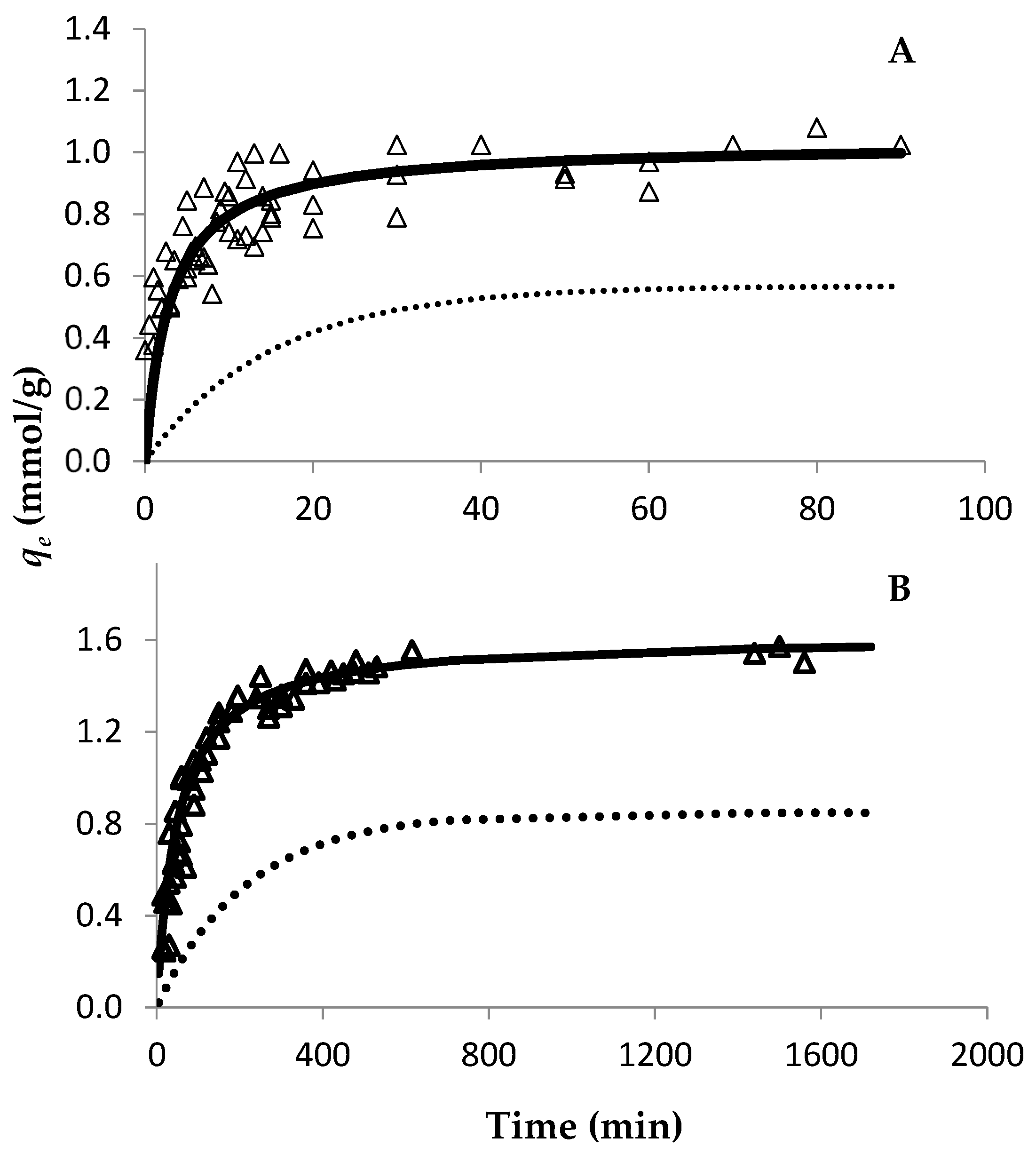
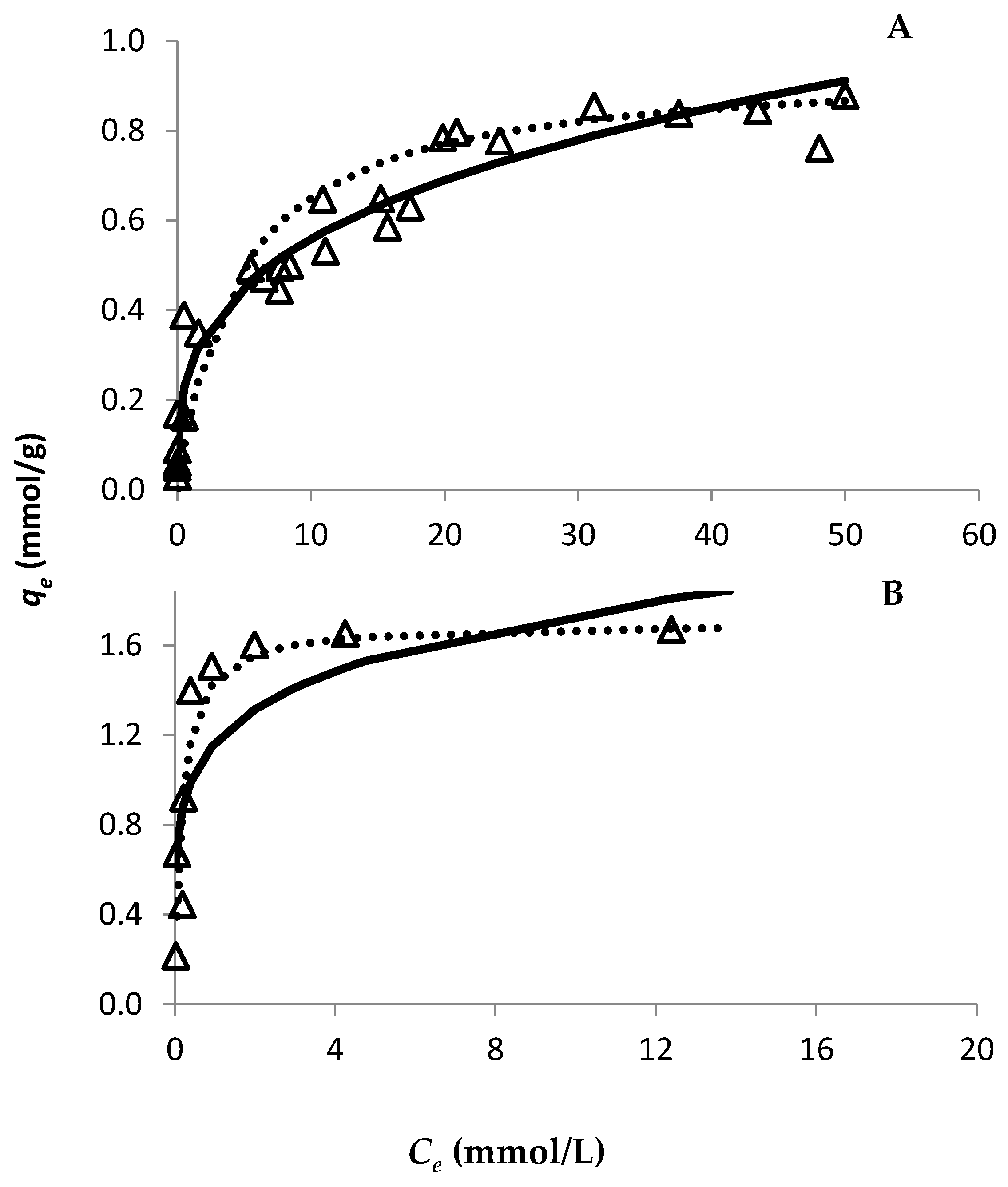
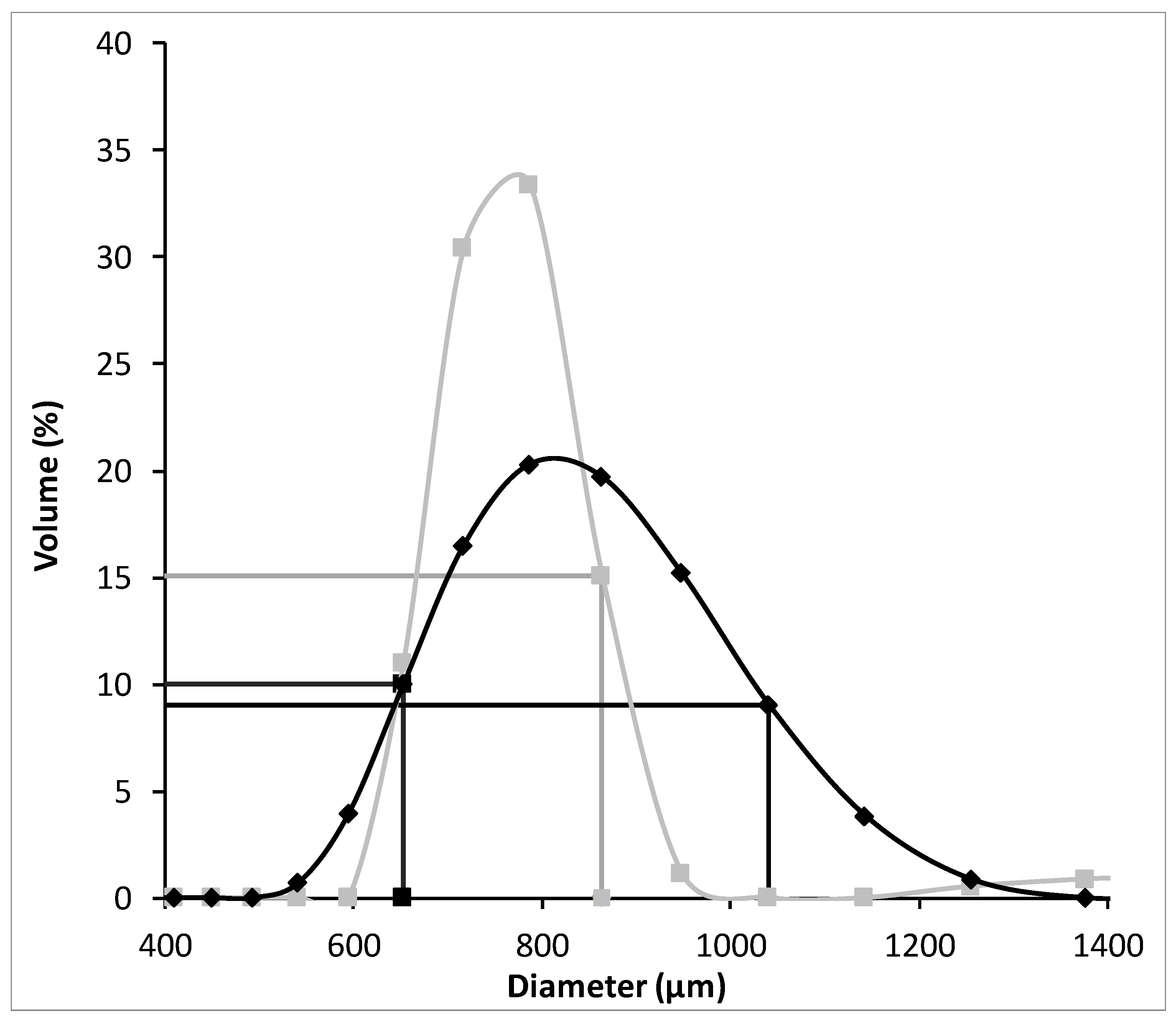
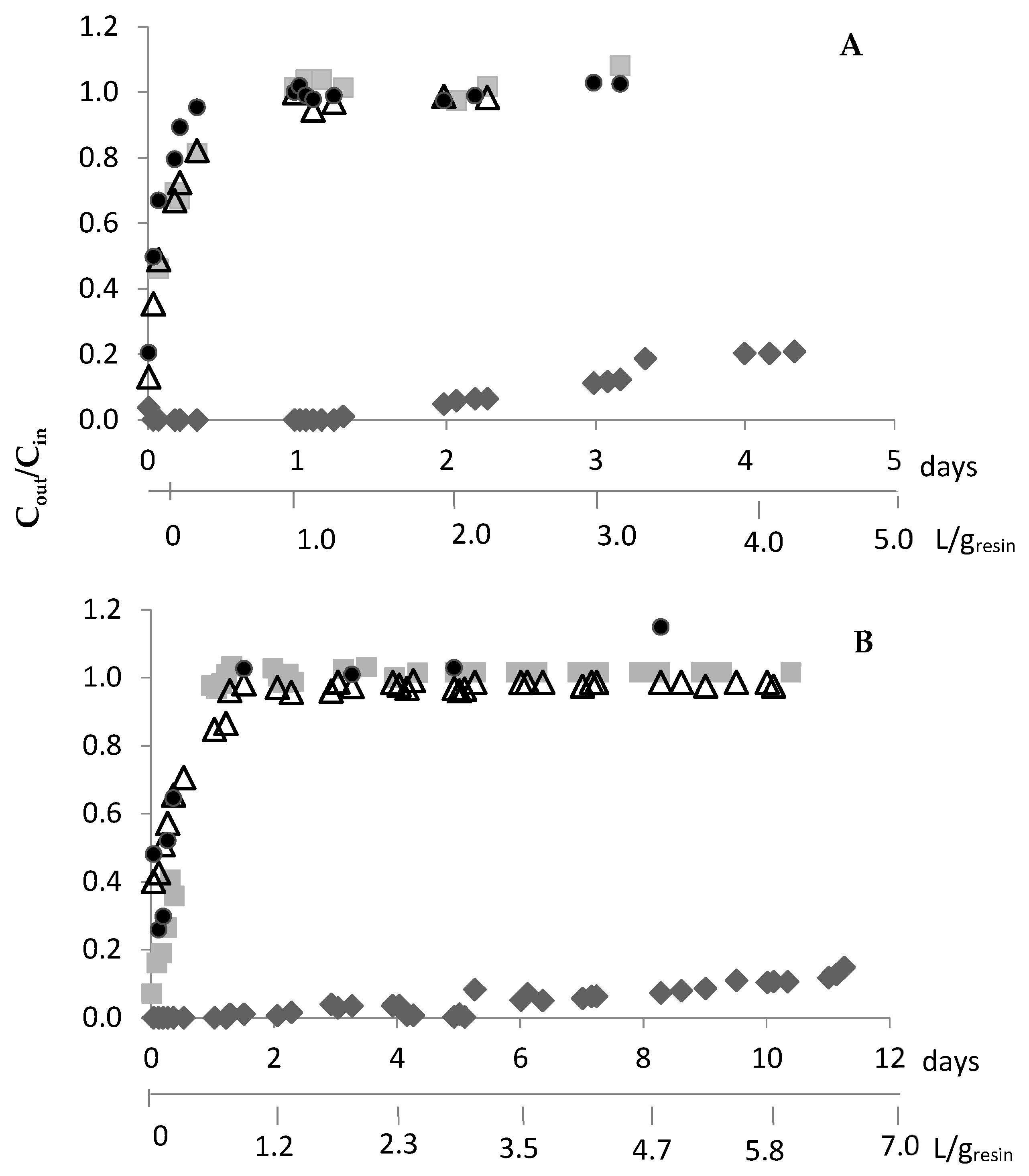

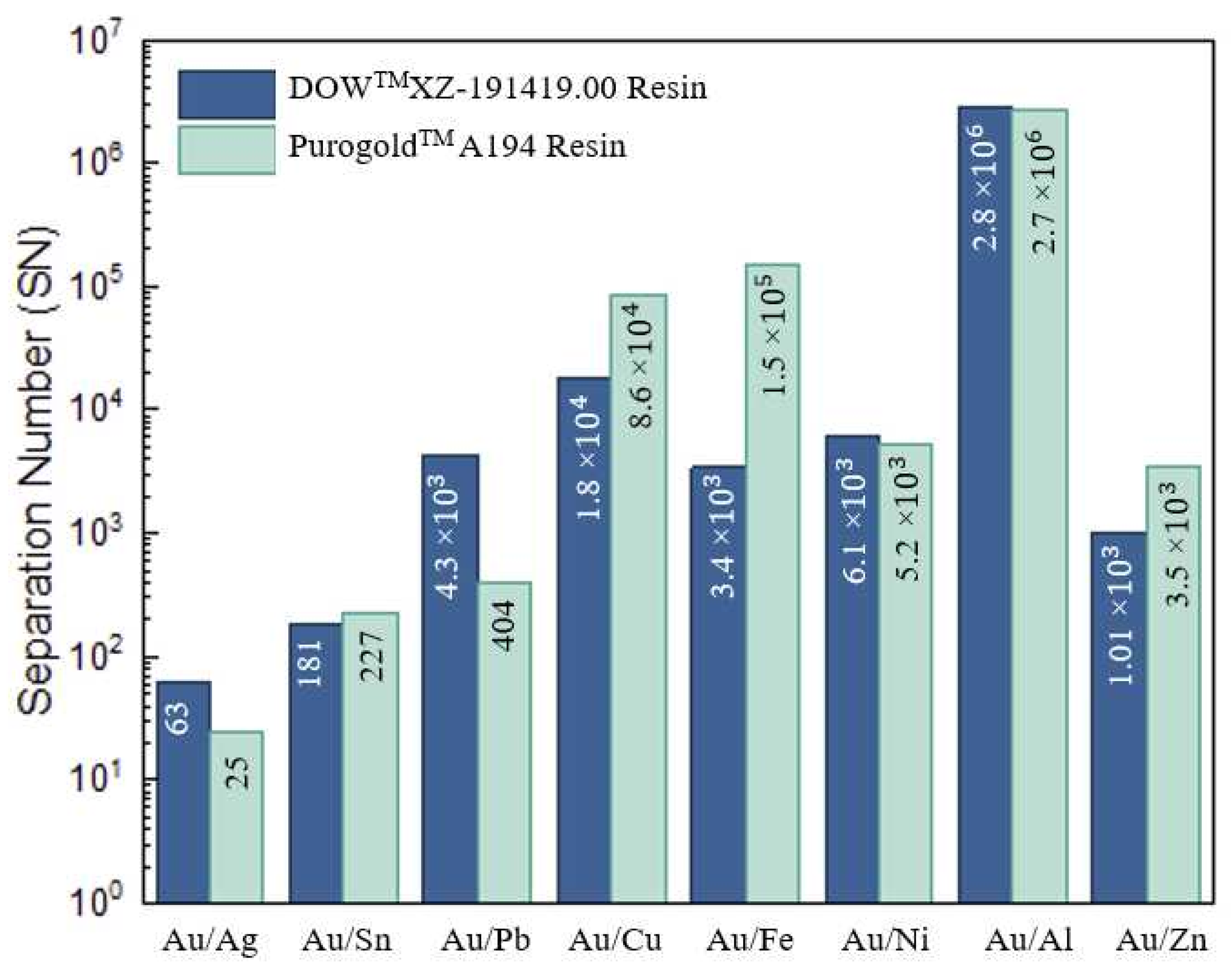
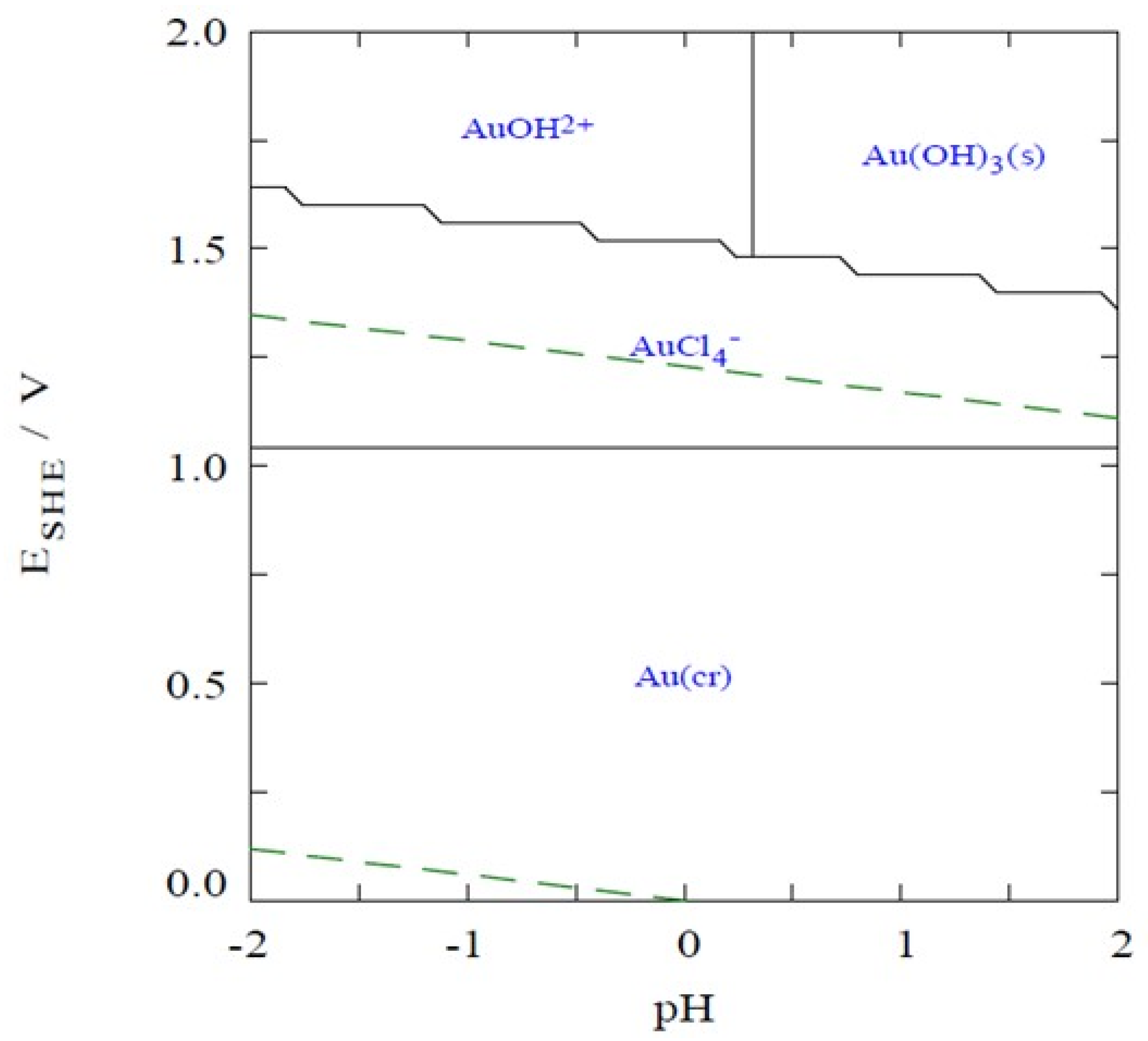
| Pseudo-First Order | Type I Pseudo-Second Order | |||
|---|---|---|---|---|
| DOWTM XZ-91419.00 | PurogoldTM A194 | DOWTM XZ-91419.00 | PurogoldTM A194 | |
| Correlation factor | 0.919 | 0.980 | 0.986 | 0.998 |
| qmax (mmol/g) | 0.57 | 0.85 | 1.03 | 1.62 |
| K1 (min−1) | 0.668 | 0.0046 | - | - |
| K2 (g/mmol.min) | - | - | 0.330 | 0.012 |
| Langmuir Model | Freundlich Model | |||
|---|---|---|---|---|
| DOWTM XZ-91419.00 | PurogoldTM A194 | DOWTM XZ-91419.00 | PurogoldTM A194 | |
| Correlation factor | 0.993 | 0.998 | 0.935 | 0.970 |
| qmax (mmol/g) | 0.94 | 1.70 | - | - |
| KL (L/mmol) | 0.22 | 5.56 | - | - |
| n | - | - | 3.29 | 5.71 |
| KF (mmol/g) | - | - | 0.28 | 1.16 |
| Resin | qmax (mmol/g) | K (L/mmol) | Reference |
|---|---|---|---|
| 1,8-Diaminonaphtalene–formaldehyde/PVC | 0.60 | 3.48 | [4] |
| Magnetic chitosan | 2.8 | 1.32 | [19] |
| Multiwalled carbon nanotubes | 0.42 | 92.8 | [5] |
| Cellulose acetate fibers | 0.56 | - | [20] |
| PPF resin | 2.57 | - | [21] |
| DOWTM XZ-91419.00 | 0.94 | 0.22 | This work |
| PurogoldTM A194 | 1.70 | 5.56 |
| Inlet Solution | Eluates | |||
|---|---|---|---|---|
| DOWTM XZ-l91419.00 Resin | PurogoldTM A194 Resin | |||
| Metal (%) | Speciation | Metal% | Metal% | |
| Au | 2.0 | AuCl4− | 94.6 | 94.1 |
| Ag | 1.2 | AgClx−(x−1) | 0.84 | 2.3 |
| Sn | 14.7 | SnCl5−/SnCl62− | 3.9 | 3.1 |
| Cu | 43.0 | Cu2+/CuCl+ (80.1%); CuCl2 (19.4%) | 0.08 | 0.02 |
| Fe | 24.4 | FeCl2+/FeCl+2 (91.1%) FeCl3 (8.4%) | 0.40 | 0.008 |
| Ni | 3.5 | Ni2+/NiCl+ (99.6%) | 0.04 | 0.03 |
| Pb | 3.1 | PbCl2 (53.4%); PbCl+ (10.7%); PbCl3−/PbCl4−2 (35.6%) | 0.06 | 0.44 |
| Al | 6.6 | Al3+ | <0.0008 | <0.0001 |
| Zn | 1.5 | Zn2+/ZnCl+ (24.5%); ZnCl2 (31.8%), ZnCl3−/ZnCl4−2 (43.7%) | 0.08 | 0.02 |
| Physicochemical Properties | DOWTM XZ-91419.00 | PurogoldTM A194 |
|---|---|---|
| Matrix | Styrene divinyl benzene gel | Polystyrene structure crosslinked with divinylbenzene |
| Functional groups | t-butylamine, quaternary amines | Mixed tertiary and quaternary amines |
| Physical appearance | White spherical beads | Brownish-cream spherical beads |
| Exchanger type | Strong base | Strong base |
| Exchange capacity (in chloride form, mol/Kg) Particle size (µm) Moisture retention (%) | 0.31 760–1200 <768 (5%) 45–55 | 3.0 800–1300 <800 (5%) 44–52 |
Disclaimer/Publisher’s Note: The statements, opinions and data contained in all publications are solely those of the individual author(s) and contributor(s) and not of MDPI and/or the editor(s). MDPI and/or the editor(s) disclaim responsibility for any injury to people or property resulting from any ideas, methods, instructions or products referred to in the content. |
© 2025 by the authors. Licensee MDPI, Basel, Switzerland. This article is an open access article distributed under the terms and conditions of the Creative Commons Attribution (CC BY) license (https://creativecommons.org/licenses/by/4.0/).
Share and Cite
Neto, I.F.F.; Silva, M.A.D.; Soares, H.M.V.M. Effective Recovery of Gold from Chloride Multi-Metal Solutions Through Anion Exchange. Recycling 2025, 10, 64. https://doi.org/10.3390/recycling10020064
Neto IFF, Silva MAD, Soares HMVM. Effective Recovery of Gold from Chloride Multi-Metal Solutions Through Anion Exchange. Recycling. 2025; 10(2):64. https://doi.org/10.3390/recycling10020064
Chicago/Turabian StyleNeto, Isabel F. F., Márcia A. D. Silva, and Helena M. V. M. Soares. 2025. "Effective Recovery of Gold from Chloride Multi-Metal Solutions Through Anion Exchange" Recycling 10, no. 2: 64. https://doi.org/10.3390/recycling10020064
APA StyleNeto, I. F. F., Silva, M. A. D., & Soares, H. M. V. M. (2025). Effective Recovery of Gold from Chloride Multi-Metal Solutions Through Anion Exchange. Recycling, 10(2), 64. https://doi.org/10.3390/recycling10020064




